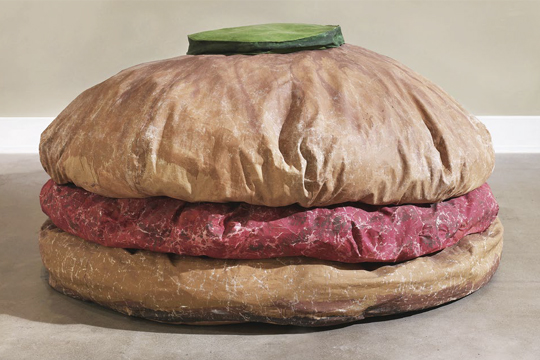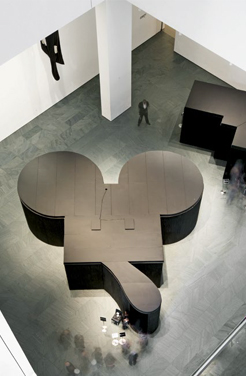CLAES OLDENBURG
| July 18, 2013 | Post In LEAP 21

PHOTO: Sean Weaver
In Claes Oldenburg’s 1960 statement “I am for an Art,” the artist gives his written phrases the same vivid palette and wily elasticity as his genre-defying artwork. The piece would soon be hailed not only as the artist’s personal manifesto, but also a mantra for American Pop Art, which at that moment was busy chipping away at the precious exceptionalism the Abstract Expressionists had fought so publicly to build. Who needs the murky language of the Jungian unconscious, Oldenburg reasoned, when the real vernacular was wrought in the streets? He advocates “an art that takes its form from the lines of life itself, that twists and extends and accumulates and spits and drips, and is heavy and coarse and blunt and sweet and stupid as life itself.” Or, slightly less eloquently: “I am for an art that embroils itself with the everyday crap and still comes out on top.”
It is difficult to gauge what exactly Oldenburg meant by “on top,” but needless to say, the work he produced in the 1960s and 70s would cement his reputation as one of the foremost figures in the postwar art world, helping to define not only Pop but Postmodernism. To honor this legacy, the Museum of Modern Art has carved a selective retrospective from three pivotal early bodies of work: The Street (1960), The Store (1961-64) and Mouse Museum (1972) with its subsequent Ray Gun Wing (1977). When brought together, what the projects really put on display is Oldenburg’s ambiguous relationship to the institution; after all, any challenge to what art can look like implicitly also challenges the way it should be looked at, and Oldenburg, as we know, is for an art “that does something more than sit on its ass in a museum.”
Take for example The Street, a “metamorphic mural” that in 1960 transformed the basement of Judson Memorial Church into a Lower East Side sidewalk, its close quarters littered with tenement trash and newspaper scraps, and patrolled by figures fashioned from used cardboard and burlap garbage bags. Just after The Street’s January debut, Oldenburg created a tidier, transportable version for the Reuben Gallery, one of the so-called Tenth Street Galleries, which would make its name hosting happenings by Allan Kaprow, Red Grooms, and Jim Dine. This second variation may have acknowledged the gallery context, but it still managed to preserve this sense of immersion and overstimulation. Now relocated into the white cube of the MoMA’s soaring sixth floor galleries, The Street is suspended in more ways than one; its objects are strung up like husks, with carefully orchestrated shadows to atone for the vast empty spaces between them. In this dissected view, one gains an appreciation for Oldenburg’s volatile sense of scale, which condenses a street sign almost reading EMPIRE (the “M” and “I” have gone missing) into just under five feet, while Street Chick (Hanging) stretches out over ten feet long. In an interview, the artist lauded the idea of floating the works as an “imitation of life,” but the closest comparison may be a meat locker, with the drastic figures literally at the ends of their ropes.
Amidst the sidewalk solicitations and the men just passing through, one encounters an object right out of a comic book. A bulky black bauble made of papier-mâché, Empire (Papa) Ray Gun (1959) sooner resembles an uprooted tulip, head drooped towards the roots. The fictional weapon was an object of utmost fascination for Oldenburg; if, in a flyer for an exhibition, the artist identified himself as the “Curator of Realism and Surrealism,” what better armament than the ray gun, an instrument that exists between the two? Conceived at the limits of the American imagination, the sci-fi accessory became Oldenburg’s calling card.

PHOTO: Jason Mandella
In 1961, Oldenburg set up the 107 East 2nd Street storefront as the “Ray Gun Manufacturing Company.” He promptly set about stocking it with color-soaked sculptures of commodity goods, be it the brandless brigade of chocolate bars stationed at the Candy Counter, the lurid promises of the Lingerie Counter, or the unkempt Cash Register. From December 1961 to January 1962, visitors could purchase objects from what the artist simply called The Store, at prices ranging from USD 29.99 to 499.99. Alas, these bargains are nowhere to be found at MoMA. The Store is now presented through a relief of its relics, with the individual objects isolated on pedestals or under glass. Oldenburg may have been for “an art you can sit on,” but his soft-sewn, sofa-sized sculptures—Floor Burger, Floor Cake and Floor Cone, all 1962—are firmly off limits. As with The Street, scale ranges wildly; a stack of life-size pies pale beside the two-foot long Potato #1 (1963), while Two Cheeseburgers with Everything (1962) are only that much more mouthwatering when super-sized. If anything, the overabundance starts to sicken, with the khaki-colored creams spread across the Tartines (1964), or the gross excess of yellowing condiment in Saumon avec mayonnaise (1964).
If Oldenburg wanted his art to engage with “real life,” then he must also acknowledge what “real life” means for art—namely, sitting on its ass in a museum. Rather than feign ignorance of the museum’s demands, the artist makes them his own, with his Mouse Museum and Ray Gun Wing. Originally presented for the 1972 dOCUMENTA , the Mouse Museum reformatted Oldenburg’s earlier project, the museum of popular art, nyc (whose intentional lack of capitalization is in keeping with the haphazard curation of the knick-knacks it contained). The pavilion takes its form from “Geometric Mouse,” an “antidote to Mickey Mouse” developed in the artist’s drawings. Viewers enter through the nose, as if inhaled into the rodent’s sinuses. Inside the room is dark save the illuminated display cases lining the walls. The 385 objects vary from a human anatomy primer and a display of Finetex Pocket Squares to souvenir soap in the shape of an octopus and models or sketches for Oldenburg’s larger sculptures. In one of the more eye-catching sections, a double-sided dildo dallies with two ketchup bottles—one a rough cardboard construction, another real glass, stripped of its label and filled with chalky gray paint.
The phallic overtones—the porcelain mushrooms and plastic lobster tails, the pink toy screwdrivers and wax popsicle candles—carry over into the Ray Gun Wing, an “annex” added in 1977. This second structure looks like a set of stairs set on its side, an architectural embodiment of the impregnated “L” that Oldenburg uses as formal shorthand for a ray gun. This wing is dedicated exclusively to that shape, presenting 258 bits of bric-a-brac that approximate the form. Items include malformed plaster casts, broken pipes and seaglass pebbles, a mangled coat hanger and a child’s novelty toothbrush. A separate ledge offers a book of photographs, re-framing cracks in concrete or crushed straw wrappers as ray guns-in-disguise.
In the ray gun, Oldenburg has found a metaphor more filling than a Floor Burger. The ray gun goes beyond the American Dream to enter the space of American dreams, trading apple pie for sci-fi, the very limits of what can be imagined, without having to sever one’s ties to “real life.” One gets the sense that, with these works, the “Curator of Realism and Surrealism” is trying to confuse the distinctions between the two, while still staying grounded in the former. To use Oldenburg’s own metaphor, his is “the art of conversation between the sidewalk and a blind man’s metal stick.” This exhibition allows us to eavesdrop.


